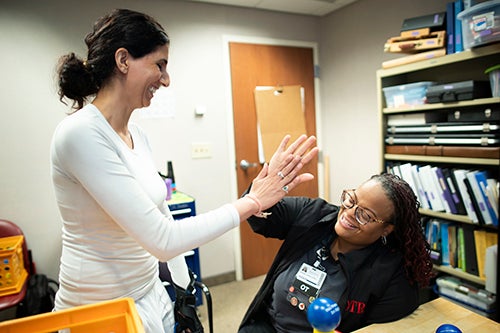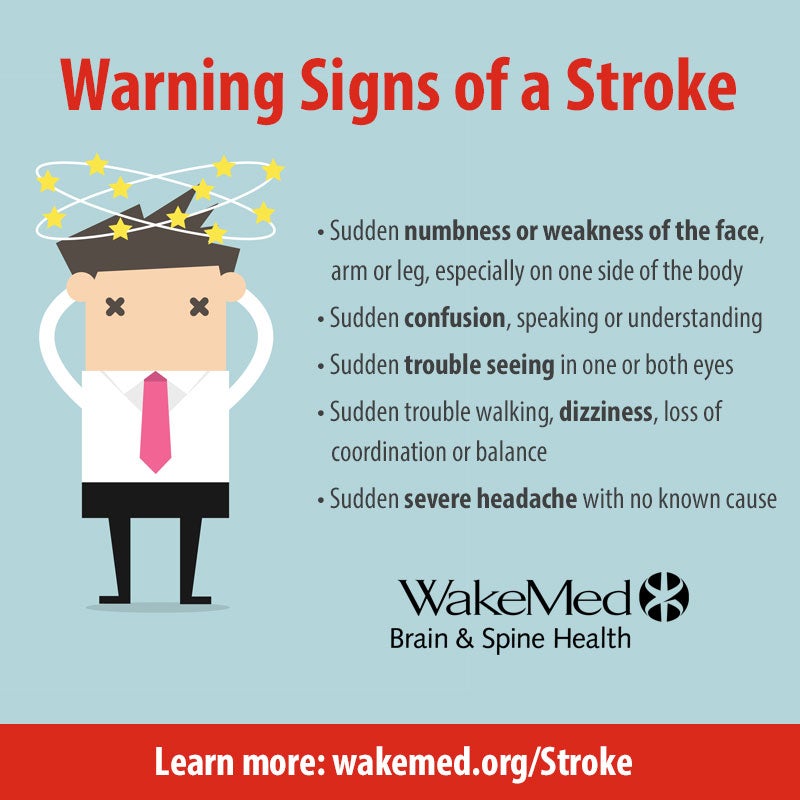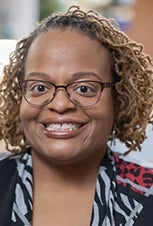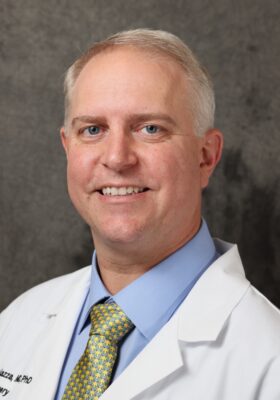Stroke at 38: New Stroke VNS Rehab Gives New Hope to Neha Zadoo
May 27, 2024
By: WakeMed Health & Hospitals
Categories: Physical Therapy, Emergency, Stories
Tags: stroke, brain injury, stroke impairment, VNS, recovery from stroke
On Friday, January 5, 2018, Neha Zadoo decided to work from home since a snowstorm was moving into the area. She set up her computer and phone in her bedroom that morning and headed downstairs for a cup of tea. Once downstairs, Neha noticed that her body was unusually sluggish and being just 38 years old, she wrote it off as exhaustion from recent holiday travel.
"I had a headache and felt clumsy while making my tea. I then realized I needed to use the bathroom, and something in my brain said to turn the stovetop off instead of putting the tea kettle on simmer. I turned it off and headed to the bathroom."
Sudden Paralysis
In an attempt to position herself over the toilet, Neha realized that try as she might, she was unable to do so.
She then experienced a constriction of her right shoulder as she attempted to stabilize herself — it passed, but she still could not bend at the waist.
Desperate, Neha stepped into the tub and realized she had difficulty grasping anything for balance. Standing erect, she relieved herself.
While cleaning up, Neha slipped in the tub and landed unconscious.
"Prior to this experience, my only known medical condition was an underactive thyroid. My blood pressure, cholesterol and weight were all in normal range. I was also not a smoker, did not consume alcohol or recreational drugs and prided myself an avid athlete."
A Call to Wake Up
Neha remained in the tub — moving in and out of consciousness — for approximately three hours. In waves, she could hear her deceased grandmother whispering "Uth," which means "wake up" in her native Hindi language.
Eventually, Neha heard a sound that she assumed was her doorbell, and immediately her Rottweiler began barking. Startled, she woke up and feebly pulled herself out of the tub. With no recollection of the morning's events, she assumed that the doorbell was for a playdate she'd planned that evening after work. Neha used her arms to hurl her body out of the tub and wield it forward out of the bathroom. No one was at the front door, so she clawed her way upstairs.
"When I left the bathroom and made my way upstairs, I realized that it was early afternoon, and I knew something was not quite right. I still assumed I was just overly tired from my trip to Virginia. To be sure, I called a friend to come check on me after he got off work that night."
Flashback to a Foreshadowing
While lying there, mostly helpless, Neha recalled a conversation months prior with a man she'd met while walking her dog at the park.
"A man with a traumatic brain injury from a car wreck had recently moved into the neighborhood. He shared his story of overcoming this event and relearning to use his body. He shared his amazement in not having a single lingering scar from the event."
Reflecting on that memory and considering her current state, Neha thought it might be wise to call 911, but she thought about her Rottweiler and feared the emergency medical technicians might not have a pleasant experience if they burst through the door. So, she dismissed the thought and awaited the arrival of her friend.
"That evening around 7:00 pm, my friend arrived. He checked my body and noticed I had a small bruise on my hip. He made me a bowl of soup and gave me a pain reliever and a soda."
A Concerned Friend Comes to Help
He then urged Neha to go to the hospital.
"I declined emergency assistance feeling confident that I just needed to sleep it off. I promised him that if I didn't feel better by Monday, I'd definitely visit my doctor."
That night, her friend had a vision that something was terribly wrong. He came over the next morning, told Neha she was going to the hospital and called 911.

Emergency Medical Services Steps In
That Saturday, January 6, when emergency medical services arrived, an emergency medical technician came into the home, placed Neha on a stretcher and brought her downstairs. Two workers remained in the ambulance and checked Neha's vitals.
"When we went into the ambulance, the only thing I remember is being told, "Stay awake. We're going to take your blood pressure. My blood pressure was normal, but I had an excruciating headache, and I remember it felt as though we hit every single pothole along the way. I went unconscious after that."
Neha was rushed to a nearby hospital in Durham and underwent imaging.
"My parents were in India, so I gave them my sister's name who lives in Minnesota. I gave them her phone number also. I was then placed on a steel gurney with a bright light above my face. I went unconscious."
She was admitted to the hospital, diagnosed with an ischemic stroke, and the team did a thrombectomy to manually remove the blood clot in her brain.
Neha remained in the hospital for a month recovering from her procedure as well as receiving inpatient rehabilitation that included occupational, recreational, physical and speech therapy.
"My entire left side of my body was extremely weak. I was given Bioness [to increase lower extremity strength and function]. I received physical and occupational therapy twice per week. They also worked on my cognitive skills with puzzles that challenged me on my left side."
Along with the medical staff who aided in her recovery, Neha is grateful to her dog who barked loudly enough to wake her when she collapsed in the bathroom on that fateful January day.
Vagus Nerve Stimulation (VNS) Procedure at WakeMed
Years passed, and Neha retained left side, upper extremity weakness in her arm and fingers. So, on March 18, 2024, she had the VNS procedure with Robert Dallapiazza, MD, with Raleigh Neurosurgical Clinic.
Stroke patients who experience post ischemic stroke upper extremity weakness have a new therapy available at WakeMed. Utilizing VNS during rehabilitation therapy, 25 percent of ischemic stroke patients may benefit from this breakthrough treatment.
WakeMed is the first Triangle-area hospital, the second in the state and one of only 35 hospitals in the country to pair neuromodulation implant with intense physical therapy for stroke treatment. The neuromodulation device was FDA-approved in 2021 and helps patients recover movement in their arms and hands.
According to the American Stroke Association, findings from a recent study of ischemic stroke patients who paired VNS alongside rehabilitation therapy showed significant — and lasting — improvement in arm and hand function.
The addition of VNS is shown to generate two to three times more hand and arm function than rehabilitation therapy alone.
"Neurosurgeon Dr. Dallapiazza says everything looks great in terms of healing. I advised him I had absolutely no side effects from the implant outside of the now resolved constipation issue. I had no changes in my voice or difficulty swallowing. My stitches are healing well. He, along with the entire medical team, did a phenomenal job! This procedure is supposed to give me back functionality. Before the procedure, many things were hard and even impossible. Cooking and cleaning took a long time because I did everything with my right hand. I also could not type. I hope the surgery and therapy will result in regaining that mobility and am excited to see if it will and the overall progress. The awareness has developed and with continued therapy, the goal is to form better habits incorporating the left arm and hand and continue the momentum to full recovery as the end goal."
WakeMed Rehabilitation and VNS Therapy
Amber Lewis, a WakeMed occupational therapist, worked with Neha in VNS therapy three days per week for six weeks, per the recommended protocol — the goal being to take the same therapy that they traditionally provided and elevate it using the best evidence-based practice.
Lewis observes, "Being able to directly stimulate the brain is new territory. Now we can pair the vagus nerve, which gives input to the brain as we are doing therapy. This is blending technology and clinical elements to produce more functional outcomes. What we have been wrapping our brains around over these weeks is the number of repetitions required. We need mass, high volume practice with task specific repetition. The goal has been to get in at least 500 repetitions of a movement per session."
What's more, for Neha, the occupational therapy targeted a tiny muscle group within her fingers. Acknowledging neuroplasticity as the brain's ability to rewire itself, Neha's therapy involved expanding movement beyond her shoulder and elbow and into her wrist and finger extensions.
Lewis as such combined the SaeboGlove with vagus nerve stimulation. Ultimately, with both protocols in place, stimulation occurred within both the fingers and brain simultaneously to promote immediate hand function. The SaeboGlove put her wrist and fingers into a functional position, and she was able to use her flexors to grasp. VNS and SaeboGlove promoted rewiring for digit extension at high repetitions of movement during the arm training session.

Neha's Life Today
Neha feels she's gotten her life back since her VNS procedure and therapy. She looks forward to a bright future.
"I'm ready to get back to work, and I'd like to be in regulatory work in pharmaceuticals and public speaking to help others heal. I believe stress played a significant role in my stroke since I was in excellent health and had no genetic predisposition. I was in emotional pain due to stress in my personal relationships. My career goals are to spread the word about drug safety and mental health. I want to help lessen the volume of disability that results in people who survive stroke."
Mental Health and Stroke
According to the National Institutes of Health, "Psychological effects of stroke include depression, anxiety, post-traumatic stress disorder (PTSD), mania, psychosis, irritability and apathy, among other emotional and behavioral conditions."
Neha feels strongly about supporting stroke survivors and their loved ones in light of lingering mental health challenges after stroke.
"It’s a natural occurrence and part of the grieving and healing process. Recovery is not always the 'why' in the process, but the 'how' and 'when' questions: 'How will I get better and when will I get better?' Caregivers also need support since they support the patient with ongoing physical and emotional needs. It takes care, patience, therapy, understanding and love to reach independence."
Gratitude for WakeMed
Neha realizes that her story is a cautionary tale of what could have been. If she'd not had her dog startle her, if she'd not had a friend insist she go to the hospital, if she'd not been introduced to the VNS procedure, her story could have turned out very differently — especially since she lives alone. As a precautionary measure, she now wears a smartwatch everywhere she goes and tells others who live alone to carry a device with them at all times.
Considering all she's learned from this experience and all to whom she owes gratitude, Neha reflects, "To my neurosurgeon and neurologist, resident physician, physician assistant, anesthesiologist, occupational therapist, nurses and staff — Thank you for your dedication to care and excellence. Without you all, external supporters and most importantly — my family and God — this would not have been possible."
About WakeMed Physical Therapy
It’s our goal at WakeMed Physician Practices – Physical Therapy to get you back to your active lifestyle. Our techniques are based on national best practices to ensure you receive the latest, best treatment for your condition. We provide physical therapy and occupational therapy in Raleigh, Cary, the Brier Creek area and Apex, North Carolina.
About WakeMed Outpatient Neuro Rehabilitation
At WakeMed Outpatient Neuro Rehabilitation, our physical therapists, occupational therapists, and speech therapists excel in evaluating and treating adults and older children after stroke, spinal cord injury, traumatic brain injury, concussion, and other neurological conditions. Our practices in Raleigh, Cary and Clayton are staffed by specialty trained, passionate therapists who work one-on-one with clients to help them achieve their goals.
About Amber Lewis, MHA/MSL, OTR/L, CBIS, CSRS
 Amber Lewis is an occupational therapist who specializes in restoring function for patients recovering from various neurological conditions including but not limited to stroke, traumatic brain injury, spinal cord injury and multiple sclerosis. She treats patients on land and in the water with specialization in Neuroaquatics. Lewis has a love for learning and technology. She earned her bachelor’s degree in occupational therapy from Winston-Salem State University and dual master’s degrees in administration and leadership from Pfeiffer University. She is also a certified Brain Injury Specialist and certified Stroke Rehabilitation specialist. Lewis is trained in neurodevelopmental treatment (NDT) and Neuro-IFRAH®, whole-person rehab approach. Rehab technology can significantly benefit a patient’s recovery and ability to adapt to new ways of doing things. Lewis is a Level II Saebo clinician and is highly experienced in additional therapeutic technologies such as the Bioness H200, the Bioness Integrated Rehab System, InMotion robotic arms and the Touch bionic-robotic hand.
Amber Lewis is an occupational therapist who specializes in restoring function for patients recovering from various neurological conditions including but not limited to stroke, traumatic brain injury, spinal cord injury and multiple sclerosis. She treats patients on land and in the water with specialization in Neuroaquatics. Lewis has a love for learning and technology. She earned her bachelor’s degree in occupational therapy from Winston-Salem State University and dual master’s degrees in administration and leadership from Pfeiffer University. She is also a certified Brain Injury Specialist and certified Stroke Rehabilitation specialist. Lewis is trained in neurodevelopmental treatment (NDT) and Neuro-IFRAH®, whole-person rehab approach. Rehab technology can significantly benefit a patient’s recovery and ability to adapt to new ways of doing things. Lewis is a Level II Saebo clinician and is highly experienced in additional therapeutic technologies such as the Bioness H200, the Bioness Integrated Rehab System, InMotion robotic arms and the Touch bionic-robotic hand.
Lewis loves being a part of someone’s recovery journey and helping them regain their independence and function. Occupational therapy allows her to creatively blend science, technology and human connection to change a person’s brain and their life. In her spare time, Lewis enjoys travel and laughing with friends and family.
About Robert Dallapiazza, MD, PhD
 Dr. Dallapiazza joined Raleigh Neurosurgical Clinic in 2022 to start up and lead the functional neurosurgery program at RNC and WakeMed. He focuses on stereotactic, functional, and general neurosurgery. He’s also trained in deep brain stimulation (DBS), a procedure that treats movement disorders through electrodes implanted in the brain.
Dr. Dallapiazza joined Raleigh Neurosurgical Clinic in 2022 to start up and lead the functional neurosurgery program at RNC and WakeMed. He focuses on stereotactic, functional, and general neurosurgery. He’s also trained in deep brain stimulation (DBS), a procedure that treats movement disorders through electrodes implanted in the brain.
Dr. Dallapiazza earned his medical degree and doctoral degree in pharmacology through the Medical Scientist Training Program at the University of Iowa Carver College of Medicine. He followed that with a residency in neurosurgery at the University of Virginia School of Medicine, where he served as chief resident, and a fellowship in stereotactic and functional neurosurgery at Toronto Western Hospital in Toronto, Ontario.
He is board certified by the American Board of Neurological Surgery.
Dr. Dallapiazza has authored numerous peer-reviewed publications and contributed to several books, most recently Operative Techniques in Epilepsy Surgery. In 2021, he was named a Best Doctor by New Orleans Magazine.